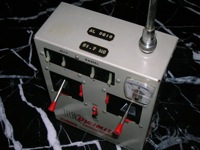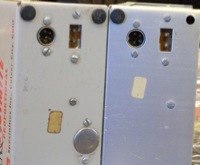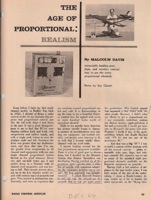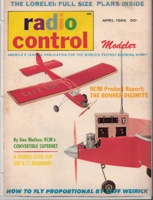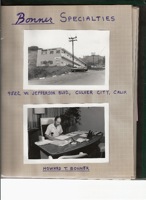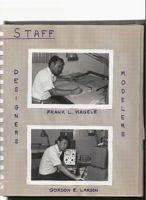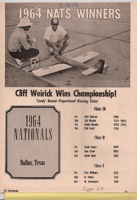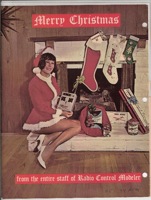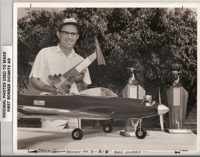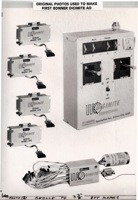Special Exhibit:
Prototype Bonner Digimite
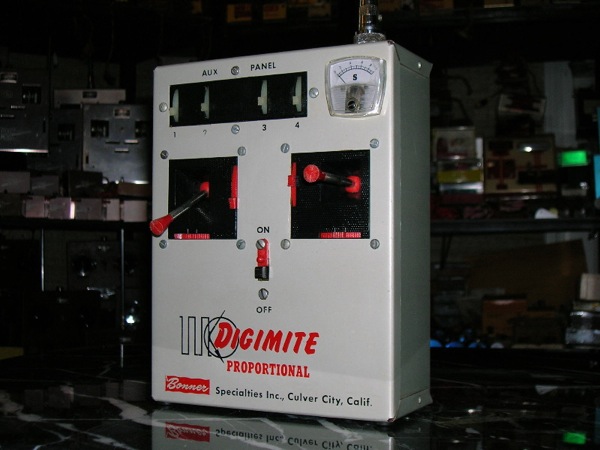
(Click on any of the images on this page to see a larger version)
This is one of the prototype Bonner Digimite proportional systems. These attractively finished units could be called production prototypes, pre-production prototypes or field test production units, but Bonner referred to them as “prototypes”. An earlier prototype flown by Howard Bonner looked nothing like these.
Somewhere between 8 and 50 of these prototypes were produced and placed with leading modelers in mid 1964 to test, win contests and produce sales-generating publicity. These prototypes varied from production models on the interior and exterior. The external differences include the curved-top ARMACO meters, large circular holes in the cases to accommodate these meters (rather than smaller rectangular holes for meters on production units), and the use of white (instead of red) control levers on the auxiliary panel and, in some cases, for trim.
There was another difference. Production Digimites had an engraved serial number on the bottom. Doig's had something else engraved there.
Here is a December 1964 RCM account of how a leading modeler had to beg Howard Bonner to get one of these prototypes and pledge to build an advanced plane capable of garnering a magazine article about how the Digimite’s 8 channels could be used.
There was a lengthy delay before production Digimites could be purchased since Howard Bonner insisted on finishing and stocking a substantial number before selling any, and was determined to produce most parts in-house despite delays due to limited in-house capacity (especially for molded plastic parts). During this prolonged pre-sale production period the only way to acquire this hot new system was to get one of the few, prized prototypes then in existence. Finally, in the second week of December 1964, the first batch of production Digimites (150 units) was released. RCM received one of these and here is how it looked for comparative purposes.
The Bonner Digimite was designed by Gordon Larson and Frank Kagele. Larson and Kagele met Bonner when they sought a quality feedback proportional servo for their new digital proportional system. Bonner had the servos and was interested in producing a complete proportional system so he invited them to come back when their system was finished. They did.
They showed Bonner their prototype digital proportional; it had only 4 of the potential 8 channels functioning, in a single stick, open-gimbal red case. Howard Bonner test flew that prototype at the Orange County Fairgrounds in his Smog Hog as he had done with Al Doig’s Ulti Multi back in 1959. The flight ended up the same way too – a crashed Smog Hog – but this was due to hitting phone lines, not a problem with the radio. Bonner was pleased with the performance of this new digital control system. He initiated negotiations to buy the design from Larson and Kagele and brought in Al Doig for assistance.
After several rejected offers Larson and Kagele signed a contract to sell their system to Bonner for $2,500 plus the right to receive 2 of the first production units for their own flying use. They also went to work for Bonner, part-time, to develop the Digimite 8. Bob Elliot, who designed the electronics for the Bonner transmite servo, may have had some involvement in refining the Larson/Kagele design into the production version, but he left Bonner in late 1963 before Digimites were produced and joined with Jerry Krause to form their own company, Logictrol. Bonner then offered Kagele and Larson positions with substantial raises over their existing jobs and they went to work for Bonner full-time.
The Digimite caused a sensation when it was released given its modern, closed – gimbal appearance and then – unheard – of 8 channels. Whether or not modelers actually needed the additional channels, they were the stuff that dreams were made of. Although called “digital” the Digimite actually employed analog servos. Thus, the servos were slow and had much less torque near their neutral position. The Digimite was an especially remarkable achievement since Bonner went directly from being a producer of secondary items like servos to making the most advanced full-house RC system of its day, with no intermediate steps such as production of single channel, reed or analog proportional radios.
Here are pictures of the Bonner factory, and of Howard Bonner, Gordon Larson and Frank Kagele. Theses pictures are all from a prototype company brochure that was never published. For a complete tour of the Bonner facility, see Bonner section.
The Digimite got off to a roaring start including 1st place at the 1964 Nationals in both Class III and Class II. Prototypes were used at that time as can be seen in this picture.
Here is the first advertisement for the Digimite featuring Nationals winner Cliff Weirick.
Here are the original 8 x 10 photos used by Bonner to make this ad. Notice there was an attempt to touch-up the picture to remove certain objects, including Cliff’s lucky rabbit’s foot on his hat. This didn’t work well and the “corny” rabbit’s foot is still visible in the ad. This hat also had a troll doll and a wishbone on it in 1964 and these were either removed or successfully touched up.
See the Bonner section for more information on this break-through historic R/C system, on subsequent systems with remarkable advances and on the mysterious electronic problem which brought the company down.
Click to download the "Bonner Digimite Story by Frank Kagele" (PDF format 2.5 MB)



